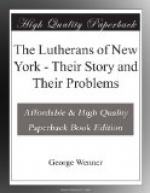The congregation, unmindful of Stuyvesant’s fulminations against all who taught contrary to the Acts of the Synod of Dort, secured as their minister in 1662 a student by the name of Abelius Zetskoorn, whom the authorities soon transported to a charge on the Delaware, without the violence, however, shown in the case of Gutwasser.
In 1664 the island was captured by the English and the Lutherans succeeded in obtaining a charter with permission to call a minister and conduct services in accordance with the teachings of the Augsburg Confession. But prior to 1664 or even 1648 there were individual Lutherans here, “their charter of salvation one Lord, one faith, one birth.” In spite of persecution, even to imprisonment, they sang “The Lord’s song in a strange land,” and in simplicity of faith sowed the seed from which future harvests were to spring.
[illustration: “When New York Was Young”]
The little trading station at the mouth of the North River now numbered about 1,500 people. The church of “The Augustane Confession” was still without a pastor. For a generation they had striven under great difficulties to maintain their Lutheran faith. They were plain, simple people, but they had refused to be cajoled or driven to a denial of their convictions. Over against Stuyvesant, the most dominant personality of the new world, they waited patiently for the time when they might have their own pastor and might worship God according to the dictates of their own consciences.
At last, in 1669, they obtained a minister in the person of Magister Jacobus Fabritius who served the congregation in New York and also one in Albany. The new pastor sorely tried the patience of a longsuffering people. In church he manifested a dictatorial and irascible temper. At home he was constantly quarreling with his wife. These eccentricities interfered somewhat with his usefulness as a pastor. With increasing difficulty he administered his office until 1671 when he accepted a call to congregations on the Delaware. Here he seems to have repented of his ways, for he left an honorable record as a devoted pastor, and the historian is glad to forget the infelicities of his career on the North River.
His successor was Bernhardus Arensius, who came with a letter of recommendation from the Consistory of Amsterdam. He is described as “a gentle personage and of a very agreeable behavior.”
Those were troublous times in which he conducted his ministry. The war between the Dutch and the English caused a repeated change of government, but for twenty years he quietly and successfully carried on his pastoral work in New York and in Albany. He died in 1691 and the Lutheran flock was again without a shepherd. For the rest of the century appeals to Amsterdam for a pastor were all in vain.
[illustrations: “A Corner of Broad Street” and “New Amsterdam in 1640”]




